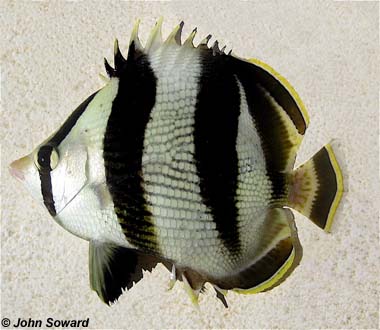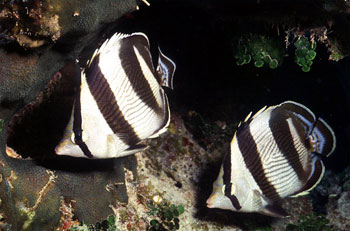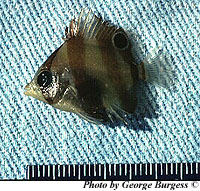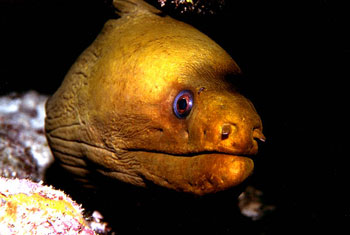
Chaetodon striatus
These small, flat, oval shaped reef fish have pointed snouts and sloping foreheads that flare out to spines and fins that encompass their profiles. As adults they are white with strong black vertical stripes and yellow highlights on their fins, but juveniles are distinctly darker colors and have an ‘eye’ spot on their dorsal fins to confuse predators. Butterflyfish form pair bonds and are quite territorial.
Order – Perciformes
Family – Chaetodontidae
Genus – Chaetodon
Species – striatus
Common Names
Common English names include banded butterflyfish, banded mariposa, butterbum, butterflyfish, portuguese butterfly, and school mistress. Other names are borboleta (Portuguese), chamba heel (Papiamento), demoiselle (French), gestreifter falterfisch (German), macamba kulu berde (Papiamento), maripose (Spanish), parche (Spanish), parche rayado (Spanish), and paru-paro (Tagalog).
Importance to Humans
This butterflyfish is not harvested for human consumption. It is often harvested for the aquarium trade, although its strange diet may make it a problem to keep in a tank. The banded butterfly tends to ignore divers, but will move away if approached.
Conservation
> Check the status of the banded butterflyfish at the IUCN website.
The IUCN is a global union of states, governmental agencies, and non-governmental organizations in a partnership that assesses the conservation status of species.
Geographical Distribution

The banded butterfly, Chaetodon striatus, is an western Atlantic Ocean species, ranging from Massachusetts south to Brazil, including the Gulf of Mexico and the Caribbean Sea. It is also found in the eastern central Atlantic Ocean near St. Paul’s Rocks.
Habitat
The banded butterfly most commonly singly or in pairs, inhabiting shallow waters around coral reefs. Swimming motion is produced through the undulation of the pectoral fins. It is a diurnal species, active during the day and sleeping at night. At the end of the day it seeks shelter since it is highly vulnerable to such night predators as moray eels, sharks, and other large reef fishes.
Biology

Distinctive Features
It is a deep bodied, thin, discus-shaped fish, designed for maneuverability about its habitat and not for long distance swimming. The dorsal fin has prominent spines in the front. Its forehead is quite concave and its snout is short.
Coloration
The appearance of the juveniles is quite different than that of the adults. They have a large, ringed black spot at the base of the dorsal fin. They do have four vertical body bars, but the overall body color is brownish-yellow instead of white. The banded juveniles are commonly found in grass beds, so perhaps the darker body color serves as camouflage. The ringed spot acts as a false eye, confusing a predator as to which end is the front of the fish. The first body bar runs down the eye, making it difficult to see and adding to the predator’s confusion. Most predators aim for the eye of their prey, and this false eye spot tricks the predator into thinking the juvenile will flee tail first. The juveniles may retain this spot up to a size of two inches, after which it begins to fade away. The ventral fins are characteristically black at all ages. The juveniles of the four-eye butterfly, Chaetodon capistratus, closely resemble the banded juveniles, but the four-eye only has two bars and two black spots on the body (while the banded has for bars plus the ringed spot).
Dentition
The small, protractile mouth has comb-like teeth arranged in narrow rows in the jaws. “Chaetodontidae” is actually derived from ancient Greek (“Chaeto” = bristle and “donte” = teeth).

Size, Age, and Growth
The adult banded butterflyfish grows to a maximum length of about 6 inches (15cm). Maturity is reached at lengths around 5 inches (12 cm).
Food Habits
The banded butterflyfish is also a predator, feeding on tube worms, sea anemones, corals, and occasionally snacking on crustaceans. The bristle nature of its teeth allows the butterfly to scrape at the invertebrates that make up its diet. This butterflyfish has also been observed forming schools of 20 individuals during plankton feeding. They may also clean parasites from other fishes including grunts, parrotfish, and surgeonfish.
Reproduction
Banded butterfly adults are most often seen in pairs. These pairs consist of a male and female, and pairing occurs early in life. The pairs are long lasting, suggesting that a monogamous relationship may exist between the male and female. Courtship between the two is drawn out and energetic. Often the fish will circle each other, head to tail, until one fish breaks and runs. They will chase each other all about the reef, and will chase away any lone fish that may approach. Actual spawning takes place at dusk, with the female releasing anywhere from 3000 to 4000 eggs. The eggs are small, pelagic, and hatch within a day. The larvae, called tholichthys, are characteristic only to the butterflyfish family. This life stage is very distinctive: the head is encased in bony armor and bony plates extend backwards from the head. The tholichthys are gray in color and almost transparent, useful adaptations for any species living in the water column. Once they reach the size of a nickel, they settle on the bottom during the night, often in large numbers. Transformation is so rapid that by the morning the tholichthys are the color of the juveniles.

Predators
At the end of the day it seeks shelter since it is highly vulnerable to such night predators as moray eels, sharks, and other large reef fishes. If the banded butterfly is threatened during the day, its first instinct is to flee the area. If escape is not possible, the fish may assume a defensive posture. The banded butterfly will turn and face its aggressor, with its head lowered and dorsal spines fully erect, similar to a bull about to charge. This may intimidate the aggressor or may remind it that the banded butterfly is much too spiny to make an easy meal.
Taxonomy
Linnaeus described the banded butterflyfish as Chaetodon striatus in 1758. The name “Chaetodontidae” means “bristle-tooth” (“Chaeto” = bristle and “donte” = tooth), describing the teeth found in this family. The Latin word striatus can be translated as “lines”, describing the banding pattern on the body of this fish. Synonyms used to refer to this fish include Chaetodon striatus albipinnis Ahl 1923, Chaetodon striatus dorsimacula Ahl 1923, Chaetodon consuelae Mowbray 1928, and Anischaetodon trivirgatus Weber & de Beaufort 1936.
Prepared by: Casey Patton and Cathy Bester